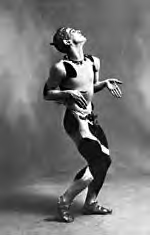
|
|
Music:
Claude Debussy. Choreography: Nijinsky.
Plot: After a poem of Stéphane
Mallarmé. Sets and costumes: inspired
by the works of Léon Bakst. Premiere:
May 19, 1912 at the Théàtre du Châtelet
in Paris. Dancers at the premiere: Vaslaw
Nijinsky (the faun), Lydia Nelidova (Leader of the Nymphs).
Nijinsky's
masterpiece is being performed with the artistry of Barry
Leon opposite Ballet of the Dolls' Julia
Tehven.
The
work was the center of controversy at its debut in 1912
over a final movement when the faun encounters the delicate
scarf of a nymph. Nijinsky created this beloved work with
static freeze like movement that resembles ancient Egyptian
characters. The movement creates an illusion of two dimensional
images that glide and shift in telling this unusual story.
|
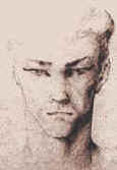
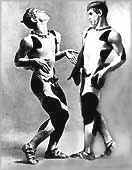
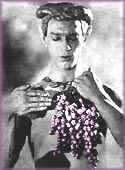

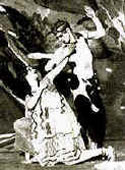
The
ballet opens with a breathy warble on the flute and the curtain
rises slowly to reveal the Faun on top of his bank, supporting
himself on his left arm, right knee raised, head tilted back
and pipe to lips; as the phrase is partly echoed by the horns
against a background of harp glissandi, then repeated on the
flute, the Faun goes through the action, in his angular, stylized
way, of squeezing first one then another bunch of grapes over
his face. On the third repeat of the flute phrase, three nymphs
walk slowly on the left. They are followed by two more. In the
course of a long tendrilly arabesque on two flutes with harp
then string accompaniment a sixth nymph walks rapidly to the
center of the stage, and takes up a pose. She then walks backwards
and joins in behind the fourth and fifth nymphs as the seventh
nymph comes on. The fist six nymphs remain motionless until
the lead nymph crosses the stage at a rapid mechanical walk,
one arm across her breast, and undone a clasp on her shoulder
to let fall her outer veils revealing a short golden undergarment.
The Faun has not stirred during the entire entry of the six
nymphs. When the leader of the nymphs comes on he followed her
with his eyes. Now a warbling clarinet sets his head moving
and a spiccato cello brings him to his feet. Forming interesting
patterns as they kneel or stand with elbows turned out from
their sides and hands either pointing at their waists or above
their heads, the nymphs move in and out as they bathe the tall
nymph in the imaginary stream to a wistful tune on the oboe.
Violins pick up the oboe phrase. A crescendo brings the Faun
down his slope on to the same level as the others. The tempo
quickens. The fourth and fifth nymphs bear off one veil to the
right; and the first second and third nymphs bear off the other
veil to the left. The music subsides into a clarinet solo ‘doux
et expressif’. The sixth nymph is stage center with her
back to the Faun. She turns to see him and raises her arms in
surprise to shoulder level, fingers splayed, and scurries off
right. The Faun and seventh nymph are left motionless as the
woodwind sing a new theme of quiet exultation. A sudden crescendo
to the languorous triplet theme. The violins take a new tune
over rippling harps. In sharp bursts the Faun courts the nymph
with a jump and changes of direction. His jump is to cross the
imaginary stream flowing from the background.. They link arms,
elbows locking, but the nymph escapes the Faun, walking off
on flat feet to the left. The music surges to fortissimo then
down again as singly and in pairs the other nymphs return to
fetch the remaining veil. A solo violin plays, accompanied by
sustained horns and warbles on the flute and clarinet. The Faun
tilts back his head and bares his teeth in stylized laughter;
then picks up the veil and contemplates it ecstatically in profile.
Over an arpeggio harp accompaniment the flute plays it’s
original tune. An oboe plucks away. To a downward rush of woodwind
three nymphs glide on to mock the Faun. The oboe takes up the
tune, and they scuttle off, hands raised. As the cor anglais
trill and flutes flutter the sixth nymph walks on from the right,
confronts the Faun with a defiant stare, then goes off abashed.
Again the flutes repeat their tune supported by shimmering strings
and the quiet ring of cymbales antiques. The Faun, alone again,
returns to his bluff and nods his head over the veil, nuzzles
it, then stretching it out over the ground, lowers himself on
it, head tucked under, and finally, as muted horns and harp
harmonies over a quiet flute chord conclude the choreographic
poem, consummates his union with it, taut to the ground, by
a convulsive jerk. We are to imagine that this is his first
sexual experience. According to conversations with Marie Rambert.







